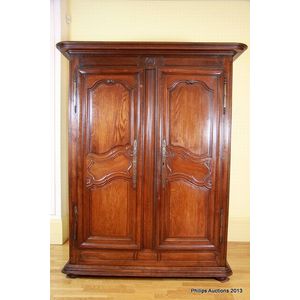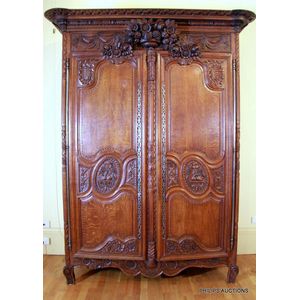Louis XV Oak Armoire with Wheel Cut Steel Escutcheons
You must be a subscriber, and be logged in to view price and dealer details.
Subscribe Now to view actual auction price for this item
When you subscribe, you have the option of setting the currency in which to display prices to $Au, $US, $NZ or Stg.
- Cabriole Leg - The cabriole leg evolved from an elongated scroll, curving out at the knee which may or may not be carved, and forming a serpentine shape as it descends to the foot.
First introduced into English furniture in the late 17th century, cabriole legs were widely used during the Queen Anne and early Georgian periods, where they frequently terminated in a pad foot or ball and claw foot. The style has had many imitators since then. The cabriole leg was re-introduced in the mid-19th century, and is commonly associated with the balloon-back dining or drawing-room chairs made in walnut, mahogany or, in Australia, cedar. The Victorian cabriole leg, on the whole, was rather more slender than the earlier form, following the French style, which emphasized the delicacy and daintiness of the chairs they were designed to support. Cabriole legs are sometimes found on windsor chairs, especially those made during the 18th century. - Cornice - The upper section of a high piece of furniture such as a bookcase, wardrobe or cabinet that sits immediately on the main structure. The cornice is usually decorated with a variety of architectural mouldings, worked either with a moulding plane or, from the later 19th century, by machine. The front and side of the cornice are mitred together, strengthened by glue blocks, and the back is generally a simple dovetailed rail to hold the structure together. Cornices are generally, though not always, fitted separately to the piece and are held in place either by screws sunk into the top board or by wooden corner blocks. A pediment may sit above the cornice, but sometimes the terms cornice and pediment are used interchangeably.
- Escutcheons - An escutcheon is a plate, made of brass, wood, ivory or ebony, which fits into or over the h keyhole, to protect the edge of the timber keyhole from damage by continual insertions of the key. As a general rule you would expect these escutcheons to be sympathetic in design to the handles of the piece. From the early 19th century escutcheons were sometimes made from ivory, ebony, bone or contrasting wood, often cut in a diamond or shield shape and inlaid into the front. Ivory, in particular, will tend to discolour with age, and certainly should not show up as brilliantly white.
- Provenance - A term used to describe the provable history of an antique or work of art, and thus an additional aid to verifying its authenticity. Provenance can have an inflating effect on the price of an item, particularly if the provenance relates to the early settlement of Australia, a famous person, or royalty. Less significant are previous sales of the item through an auction house or dealer.
- Cut Steel Decoration - Cut steel decoration is a technique used in the production of jewelry and other decorative items that involves cutting steel pieces into small, faceted shapes and then attaching them to a metal base. These small steel pieces, often called "cut steel beads" are then arranged to form intricate designs, and then attached to a metal base to create a piece of jewelry. This technique was popular in the 18th and 19th centuries, particularly during the Georgian and Victorian eras.
The steel pieces were usually cut with a chisel and hammer, the process was time consuming and labor-intensive, and required a high level of skill. The steel was cut and shaped into small beads or other decorative shapes, and then polished to a high shine. These beads were then strung together or attached to a metal base to create a piece of jewelry or other decorative item.
Cut steel decoration was often used to create jewelry, such as necklaces, bracelets, and earrings, as well as other decorative items, such as buttons and buckles. The jewelry was particularly popular during the Georgian and Victorian eras, as it was considered fashionable and was relatively inexpensive to produce. - Oak - Native to Europe and England, oak has been used for joinery, furniture and building since the beginning of the medieval civilisation. It is a pale yellow in colour when freshly cut and darkens with age to a mid brown colour.
Oak as a furniture timber was superceded by walnut in the 17th century, and in the 18th century by mahogany,
Semi-fossilised bog oak is black in colour, and is found in peat bogs where the trees have fallen and been preserved from decay by the bog. It is used for jewellery and small carved trinkets.
Pollard oak is taken from an oak that has been regularly pollarded, that is the upper branches have been removed at the top of the trunk, result that new branches would appear, and over time the top would become ball-like. . When harvested and sawn, the timber displays a continuous surface of knotty circles. The timber was scarce and expensive and was used in more expensive pieces of furniture in the Regency and Victorian periods.
This item has been included into following indexes:
- armoires 300
Visually similar items

Vintage French Louis XV style carved oak two door armoire

Louis XIV walnut armoire, double pediment with interior shelves and drawers, bun feet 18th century. 245 cm high, 167 cm wide, 76 cm deep

A Louis XVI provincial oak armoire, late 18th century, the moulded cornice and carved frieze above a pair of well-moulded double-panelled doors flanked by fluted corners, the base moulding above flattened bun feet, the sides panelled, with decoratively sha

A provincial Louis XV style oak armoire from Normandy, 19th century, with an extended cornice with relief carved borders, a carved urn with abundant flowers and bursting fruits sitting proud of the frieze, the panelled doors similar with various borders an
